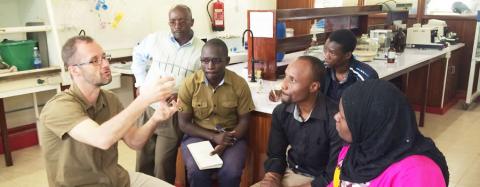Dr. Aleš Soukup talking to staff on plant histology

Dr. Ales Soukup made a scientific presentation on 12th April 2018 at the College of Natural Sciences, Makerere University. In the presentation entitled: “Rooted to the spot – root system structure, function and development, Dr. Soukup clarified that his research is mostly centred on developmental biology, histology and anatomy but less in molecular biology which is a focus of another research group at his Department of Experimental Plant Biology. He provided an insight into how lateral roots develop in plants with details of how different growing conditions in the field and hydroponics influence plant growth. Different genes are also down regulated or up regulated in the site of lateral roots development, using the example of the standard model plant Arabidopsis thaliana.
Furthermore, Dr. Soukup described the role of the Casparian strip, a band of suberin (an impermeable substance), found in the endodermal cell walls of plant roots. The casparian strip is chemically different from the rest of the cell wall - the cell wall being made of lignin and without suberin whereas the casparian strip is made of suberin and sometimes lignin. Just as the shoot system of plants is protected from dangerous aerial substances by cuticle, the root system is protected by the casparian strip.
He emphasized that plant histology and anatomy as disciplines belong to pure science category and have unfortunately been ‘orphaned’ or ‘abandoned’ with very few research groups across the world on these disciplines. This is because many research funding platforms / organizations do not view their immediate applications. However, in several other disciples e.g., genetics, molecular biology biotechnology, pathology that may seem to have immediate applications, progress is greatly halted because there is sheer lack of anatomical and histological input where needed.
He thanked Assoc Prof Arthur Tugume for his invitation to share his experiences, both in the laboratory where studies are focusing on banana histology using a fluorescent microscope, and this presentation.
